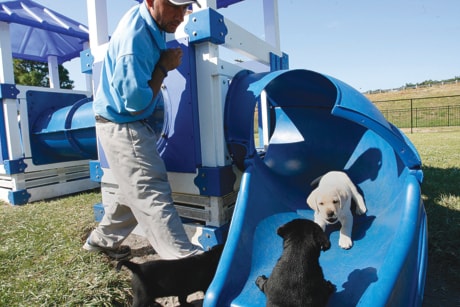RIVERVIEW, Fla. — Picture yourself venturing out at night, down an unknown street, blindfolded. An occasional car flies by, the intermittent pockets of deathly silence offering no support.
Difficult? Nerve-racking? Downright petrifying?
Not for Jeff Redford — thanks to Don, a large black Labrador.
In what might as well be another life, Redford, 61, was a sniper in Vietnam, a guard for President Richard Nixon, an employee of the Marine Corps’ prison system, a pipe fitter and the owner of a barbecue restaurant.
Then he lost night vision and depth perception. He went blind in the right eye and as good as blind in the left.
Stepping out of the house alone became unthinkable.
Years went by. But a couple of months ago, he met Don, who taught him not to fear a dark, unfamiliar street. The guide dog was exactly what Redford needed.
“You realize that you’ve turned your life over to a dog” to gain independence, he says.
Redford and Don came together through Paws for Patriots, a program for veterans with limited or no vision. It was started by Southeastern Guide Dogs of Palmetto, Fla., a non-profit organization that breeds, trains and gives away dogs to the visually impaired. Relying entirely on charitable donations, Southeastern Guide Dogs boasts it’s one of only a dozen certified guide dog schools in the country.
Its mission: to provide people like Redford with another source of companionship, while enabling them to live with freedom and dignity.
Before Don, Redford depended on his family for everything. Drivers ran over his cane.
Kids tripped over it and fell.
“Now, with him,” he says, nodding toward Don, sprawled silently at his feet, “I just go.”
H H H
“Good girl!” Janet Deluca, 46, tells Elsie every time the black Lab stops at a curb or skirts a small puddle.
The two are out together for the first time, leading one another along a meandering path at Southeastern’s 23-acre campus.
Deluca is in the latest batch of nine “students” at Southeastern. They spend nearly a month at the facility, getting to know their new dogs.
This is Deluca’s first time with a guide dog. Her eyes were once perfect. But after an autoimmune disease called Behcet’s took hold, her vision disappeared. She learned to rely on a cane for nearly 16 years — until Elsie.
“She’s such a sweet partner,” Deluca says, smiling, her eyes hidden behind dark glasses.
Elsie, like the other dogs at Southeastern, went through months of extensive training, learning 40 different commands. When her harness is off, she can run, play — just be a regular dog. But the moment it’s back on, the canine knows she’s on the job.
She has learned to stop at every curb, find doors and exits and, most important, take responsibility for someone’s life.
On their first walk together, it is clear that Deluca and Elsie are a team. When a familiar face or smell distracts Elsie, Deluca gets her back on task with a firm “no.” In turn, every time Deluca drifts to one side, Elsie gently pushes her back to the middle of the path. Thanks to Elsie, Deluca talks of freedom and self-reliance, of traveling to new places, of telling others like her how her life will change.
As the walk ends, Elsie guides her to a door. Deluca goes in, takes off her glasses and dabs her wet eyes.
“Can I cry now?” she says, with the smile that never left her face. “I just want to cry.”
H H H
“You can’t hug a cane.”
Hearing that testimonial from her students gives Leanne Gossner a reason to come to work every day.
For Gossner, a Southeastern canine trainer who also teaches people to use guide dogs, the biggest challenge — and biggest source of satisfaction — is ensuring that the dogs she trains will one day take care of someone.
“You see this new person,” Gossner says of the transformation she sees once people get accustomed to guide dogs. “They get to travel a street they’ve been terrified of forever.”
H H H
Gaining confidence can take a while, says Dolores Myers.
Myers, born blind, got her first guide dog through Southeastern nearly 10 years ago. She was still hesitant and scared — until one day, out with her black Lab, Jet, it began to pour. The rain drowned out city sounds Myers needed to hear. Helpless, she tugged on the leash and muttered: “OK, Jet . . . we’ve got to get home.”
That episode “was kind of like an eye-opener,” says Myers, 58. “I knew that he was going to get me home. We were soaked to death, but it was worth it.” Myers bade farewell to her cane. Now that Jet is retired, she is back at Southeastern — for his replacement.
